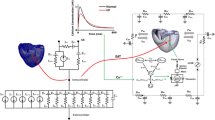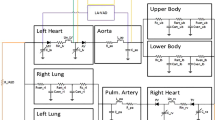Abstract
Cardiac resynchronization therapy by biventricular pacemaker/ICD implantation is a validated therapy for patients affected by heart failure with asynchrony of ventricular contraction. Considering the large number of parameters which play a role in cardiac resynchronization therapy, a comprehensive numerical model of cardiocirculatory system could be a useful tool to support clinical decisions. A variable elastance model of ventricles was updated to model the interventricular septum and to simulate the interventricular and the intraventricular desynchrony, and the effect of the biventricular stimulation. In addition, a numerical model of the biventricular pacemaker, which drives the beginning of the heart chambers and interventricular septum contraction, was also developed. In order to validate the model,
five patients affected by dilated cardiomyopathy were analysed by echocardiography and electrocardiography before implantation, 24 h and 3 months after the implantation. The developed numerical model permits to reproduce clinical data and to estimate the trend of parameters that are difficult to measure (i.e. left ventricular systolic elastance). Furthermore, the model permits to study the effect of different biventricular pacemaker temporizations on hemodynamic variables.





Similar content being viewed by others
References
Braunwald E (1988) Heart disease: a textbook of cardiovascular Medicine, 4th edn. WB Saunders Company, Philadelphia
De Lazzari C, Neglia D, Ferrari G, Bernini F, Micalizzi M, L’Abbate A, Trivella MG (2009) Computer simulation of coronary flow waveforms during caval occlusion. Methods Inf Med 48(2):113–122
Di Molfetta A, De Lazzari C, Ferrari G, Moscariello F, Aguzzi G, Fresiello L, Darowski M, Trivella MG, Alessandri N (2010) Biventricular pacemaker synchronization: a numerical cardiocirculatory model application to reproduce in vivo data. Byocib Biomed Eng 30(1):3–15
Ferrari G, De Lazzari C, Mimmo R, Tosti G, Ambrosi D (1992) A modular numerical model of the cardiovascular system for studying and training in the field of cardiovascular physiopathology. J Biomed Eng 14:91–107
Ferrari G, Kozarski M, Gu YJ, De Lazzari C, Di Molfetta A, Palko KJ, Zieliński K, Górczyńska K, Darowski M, Rakhorst G (2008) Application of a user friendly comprehensive circulatory model for hemodynamic and ventricular variables estimate. Int J Art Org 31(12):1043–1054
Ghio S, Constantina C, Klersy C, Serio A, Fontana A, Campana A, Tavazzi L (2004) Interventricular and intraventricular dyssynchrony are common in heart failure patients, regardless of QRS duration. Eur Heart J 25(7):571–578
Guyton AC, Jones CE, Coleman TG (1973) Computer analysis of total circulatory function and of cardiac output regulation. In: Circulatory physiology: cardiac output and its regulation. WB Saunders Company, Philadelphia, pp 285–301
Kerckhoffsa RCP, Lumensd J, Vernooyd K, Omensa JH, Mulliganc LJ, Delhaasd T, Artsd T, McCullocha AD, Prinzend FW (2008) Cardiac resynchronization: insight from experimental and computational models. Prog Biophys Mol Biol 97:543–561
Korakianitis T, Shi Y (2006) A concentrated parameter model for the human cardiovascular system including heart valve dynamics and atrioventricular interaction. Med Eng Phys 28:613–628
Li JKJ, Cui T, Drzewiecki GM (1990) A nonlinear model of the arterial system incorporating a pressure-dependent compliance. IEEE Trans Biomed Eng 46:673–678
Popovic Z, Vukovic M, Greenberg N, Vlahovic A, Nesakovic AN, Thomas JD (2003) Comparative value of single-beat load-independent contractility indices in dilated cardiomyopathy and mitral regurgitation. J Am Soc Echocardiogr 16:703–711
Sagawa K, Maughan L, Suga H, Sunagawa K (1988) Cardiac contraction and the pressure–volume relationships. Oxford University Press, New York
Suga H, Sagawa K (1993) Load independence of the instantaneous pressure–volume ratio of the canine left ventricle and effects of epinephrine and heart rate on the ratio. Circ Res XXXII:314–322
Tulner SAF, Bax JJ, Bleeker GB, Steendijk P, Klautz RJM, Holman ER, Schalij MJ, Dion RAE, van der Wall EE (2006) Beneficial hemodynamic and clinical effects of surgical ventricular restoration in patients with ischemic dilated cardiomyopathy. Ann Thorac Surg 82:1721–1728
van Gelder BM, Bracke FA, Meijer A, Lakerveld LJM, Pijls NHJ (2004) Effect of optimizing the vv interval on left ventricular contractility in cardiac resynchronization therapy. Am J Cardiol 93:1500–1503
Yu C, Abraham W, Bax J, Chung E, Fedewa M, Ghio S, Leclercq C, León A, Merlino J, Nihoyannopoulos P, Notabartolo D, Sun JP, Tavazzi L (2005) Predictors of response to cardiac resynchronization therapy (PROSPECT)—study design. Am Heart J 149(4):600–605
Author information
Authors and Affiliations
Corresponding author
Rights and permissions
About this article
Cite this article
Di Molfetta, A., Santini, L., Forleo, G.B. et al. Use of a comprehensive numerical model to improve biventricular pacemaker temporization in patients affected by heart failure undergoing to CRT-D therapy. Med Biol Eng Comput 48, 755–764 (2010). https://doi.org/10.1007/s11517-010-0623-0
Received:
Accepted:
Published:
Issue Date:
DOI: https://doi.org/10.1007/s11517-010-0623-0




